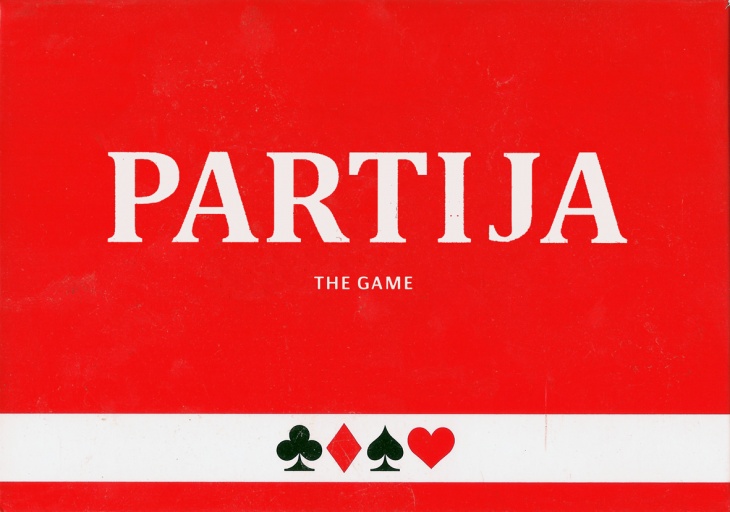Matej Stupica and Jaka Berger – Brgs: The Game
Interactive sound installation
How does the tension between playing freely and playing according to a strict set of rules, competition and unpredictability, arbitrariness and improvisation sound like?
The Game is an interactive sound installation merging the features and principles of card playing (Rummy), instrument playing and musical improvisation into a temporary performative situation. The Game’s system uses a digital interface to translate information gathered in the course of a card game into a command score, which prescribes the way differingly designed motors play on piano strings and shape a unique space for playing music in the structure of a table game. The multi-layered design of the project puts participants into two distinct roles: they either partake in the performative situation as a listeners who follows the game and the music dictated by the game, or actively participate in the gameplay and becomes a part of this (un)predictable interactive sound situation.
Text by Lenka Đorojević.
Vsebina
Past events
- Mets Fest; Music of the (W)edge – Festival Europeo di Creatività Digitale, Cuneo | 8 – 13 April 2022
- konS modul, Velenje | 16.2. – 19. 3. 2022
- konS modul, Nova Gorica (xcenter) | 7. 7. - 18. 9. 2021
- / konS @ 25th International Festival of Computer Arts IFCA, Maribor (Pristan/Stanivest) | 11.10. - 20.10.2019
- 19 – 28 June 2018 @ Layer House, Kranj, Slovenia
- 15 June 2018 as part of a plenary meeting of experts AA EBU: @ OSMO/ZA, Slovenska 54, Ljubljana
- Additional dates: December 28 2017, January 11 & 18 2018 and January 25 2019
- Opening: December 21 2017 at 8 PM @ OSMO/ZA, Slovenska 54, Ljubljana
Booklet
The Game: playing or playing
The Game is an operational model within which a specific space is created according to particular rules and temporal limitations. According to Eugen Fink, the world of game is: “nothing ‘more’ or ‘less’, when compared to other things; it is ‘more’ only because it is also ‘less’ at the same time. The world of games is a symbol of the real world in the visual medium. /…/ Torn between perfect practical inefficiency on the one and rules and regulations on the other side, The Game is a metaphor of cosmos by its qualities and thus represents a medium that enables an individual to determine their relation towards being, fellow humans and the world.” (Strehovec, Janez, »Igra kot igra«, in: Teorije igre pri Johanu Huizingi, Rogerju Cailloisu in Eugenu Finku, Študentska založba, Ljubljana, 2003, pg. 354–355.)
The Game is both a game and a playground for 2–4 players, 16 electro motors and a string-table. It combines the principles and peculiarities of a card game (Rummy), of playing a musical instrument and of musical improvisation, all combined into one temporary performative situation. The Game begins by capturing the image of a played card. A digital interface then relays a card-specific MIDI signal, composed in a 4/8 rhythm, as a looped command to the mechanised percussive parts of the string-table. The hierarchical power of the played card determines the rhythmical interactions, which are then composed into a score of commands and used to proportionally influence the current musical situation.
Every move by a card game player is based on a particular distribution of possibilities, ones competitiveness and response to opponent’s moves and risk. The players’ reactions and behaviour resonate the logic of musical improvisation where all of the aforementioned open actions and procedures shape the channels of communication.
The Game resolves according to a matrix of unpredictable variations of human reactions and random outcomes which form a controlled improvisation as the card game progresses. The improvisation is controlled through a pre-determined musical score of commands that follow one another in an endless cycle of possible combinations and interactions defined by the string of cards being played.
Each game revolves around two distinctive poles; around paidia, the pole of imagination and improvisation, and around ludus, the tendency to quench spontaneity with rules and conventions. The game is played at a surreal level which asserts the domain of the not yet established. Its power lies in the fact that it disrupts the continuity of ordinary activities. By escaping from reality into fictional time and space, it establishes its territory as a temporary alternative world within our everyday reality. The project’s multi-layered design assigns two different roles to the attendants of The Game. They are both participants of an improvisational situation, in which they follow the game and listen to the sounds it produces, and card players, who become a part of (un)predictable sound-interactive situation.
The Game combines the empirical processes of playing cards and its subsequent musical performance. This way, in heterogeneous space of communication, it emits the sounds of tension between free play and play by strict rules, between competition and unpredictability, arbitrariness and improvisation. It is a hybrid instrument or even a system for performing music that can be realised only at the level of interplay between forms (Ibid., pg. 358.).
Inside the temporary zone of The Game, sound opens up temporality, acting as a disturbance in the characteristic hierarchical relationships of our reality, inside which complex organisations, systems and networks influence the increasingly torn temporal structure. The Game utilises different mediums and techniques of relaying digital and analogue processes for connecting intentions contained in playing/performing. It is those intentions that enable manipulation of sound and events. The Game speculatively s(t)imulates the potentials of (re)production, reception and participation processes and thus tests the relations between reality and fiction, the social and the individual.
Gallery
About the authors
Matej Stupica (1987) is a new media artist of the younger generation, working primarily in the field of visual art and multimedia installations. In 2014 he graduated in painting at the Faculty of Arts in Ljubljana with the work Escape from Alcatraz. During a 3-month student exchange program in the academic year 2010/2011 he attended classes in Jiří Černický's painting studio at the Academy of Arts, Architecture and Design in Prague. With solo and group projects, interventions and exhibitions he participates in Slovenia and abroad. As of 2006 he is an illustrator for the newspaper Dnevnik's Saturday supplement, Objektiv. His illustrations were exhibited at the 8th and the 11th Slovenian Biennial of Illustration, where he received the Hinko Smrekar Recognition and a special commendation of the jury for his newspaper illustration. He received the Academy of Fine Arts in Ljubljana Award in 2009 for outstanding artistic achievements for his work in the field of visual arts, and the Student's Prešeren Award for painting in 2011. With his last projects he was, inter alia, a part of the 7th and 8th Triennial of Contemporary Art U3. He lives and works in Ljubljana.
Jaka Berger – Brgs is one of the most driven and well versed drummers and percussionists on Slovenia's music scene over the past ten years. His debut, a free jazz record dubbed Bass Trio, made in collaboration with Achille Succi and Samo Šalamon, was released in 2006. He was a member of the percussion band StrojMachine, performing also with Katice and the legendary and now revived Borghesia, while today he is a permanent member of Ludovik Material and Darla Smoking. Together with Marko Karlovčec he formed the Radical Improvisation Duo, while he explores the more noisier sonic experiences alongside Vitja Balžalorsky as part of the project The B. Bees. He composes solo electro-acoustic pieces through sound layering and field recording modulation.
Credits
Conceptual idea: Matej Stupica, Jaka Berger – Brgs and Andraž Magajna
Mechanisms design: Matej Stupica
MIDI score: Jaka Berger – Brgs
PCB design and programming: Brane Ždralo
Programming: Matic Potočnik
Curator: Lenka Đorojević
Production: Ljudmila Lab (Tina Dolinšek) and Projekt Atol Institute (Uroš Veber)
Special credits: Dan Adlešič, Johannes Lohbihler, Miha Zupan, Martin Lovšin Schintr, Bojan Stefanović, Miha Kelemina, Klemen Glej and Jaka Mihelič.
Project is supported by the Slovene Ministry of Culture and City of Ljubljana – Department for Culture. The project is part of EASTN-DC Network, which is co-funded by the Creative Europe program of the European Union.







